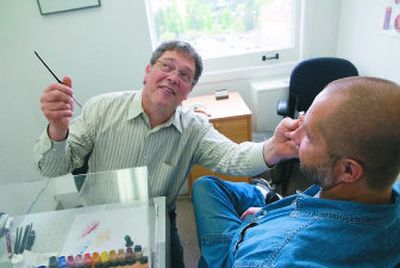Visual artist

Kim Erickson is an artist.
Anyone who sees his work would not doubt that for an instant.
But his pieces don’t hang in museums.
In fact, his masterpieces go unnoticed by all but their owners.
Erickson, like his father before him, handcrafts plastic prosthetic eyes from his office in downtown Spokane.
“My best work is invisible,” he says.
Erickson, 50, was a math major in 1978 (“and not happy about it,” he says), and was considering a career in architecture when he decided to come back home to get to know his dad, Jack Erickson. His parents split up when he was young. So, he thought he would learn more about the family business while connecting with his dad.
He didn’t really intend to stay long, but he was hooked by both the artistic and the human element of the work. It took Erickson six years of study before taking his licensing exam as an ocularist (someone who crafts prosthetic eyes).
In the meantime, he learned more about his father’s life.
“It took a lot longer to get to know him than I expected,” he says.
Jack Erickson invented this method of plastic eye-making during World War II, when he first tried to use plastic to repair glass eyes. Jack Erickson and his brother, Charlie, later founded the American Society of Ocularists. And the elder Erickson was forever fiddling with the technology to produce the eyes.
“When I was a kid, we had rabbits with contact lenses in, in front of the house,” Erickson says.
Erickson bought out his dad’s business in 1986, although Jack Erickson kept working – and tinkering – until his death in 2001 at age 85.
Erickson still marvels at his dad’s skill when he finds a prosthetic hidden away that he created, he says.
“He was the best painter I ever met,” he says.
To watch Erickson work is to understand the steep learning curve of his craft. First, he makes a mold of the patient’s socket. Then he creates a blank plastic prosthesis from that mold. With a tiny brush and a rainbow of colors before him, he sets out to paint the fine details of the iris, stopping every so often to match his work with the patient’s remaining eye. The work now takes him 30 minutes to an hour. When he first started, he spent eight hours painting.
He sees colors in the eye that most of us never notice. For one recent patient, an 84-year-old woman from Montana, he painted an iris with a dark gray-green base color and a dark reddish-brown central area. He highlighted the work with a rusty-gold colored border and dotted it with brownish freckles.
“I thought I had brown eyes,” says the woman, who lost an eye due to illness when she was just a year old.
After painting the iris, Erickson moves on to the white of the eye. The white actually has more colors than the iris, he says, they’re just muted.
And then comes the whisper-thin veins that spider their way around the white. Erickson crafts each one with “my famous ancient thread” which, he says, is older than he his. Jack Erickson bought spools and spools of the thread for 10 cents each because it makes such perfect, crinkly veins.
“The tendency for it to kink in a certain way when you stress it,” makes it so well-suited, Erickson says.
In another lifetime, Erickson could have been a bartender, maybe a therapist. He has a soothing demeanor that puts people at ease, even when he’s removing their prosthetic from its socket. He listens as well as he talks, and can swap stories with a grizzled ex-cop or a gray-haired grandmother.
About half of Erickson’s patients come to him because of disease that has attacked the eye, sometimes melanoma or diabetes or other cancers. The other half land in his office following accidents.
“I have kids from running with sticks and running with scissors,” he says. Or a branch falls from a tree at just the wrong moment. Or a rock shoots out from a truck’s wheel.
Erickson knows the effects of freak accidents. His father never let him play with a BB gun or slingshot as a child. His daughter, 23-year-old Monica Erickson, is working alongside her father, learning the trade while she goes to college. She laughs about it now, but she remembers the time her dad made her wear a welder’s mask while trimming the lawn.
Bill Loomis of Lind, Wash., has worn a prosthetic eye since 1973 after he was wounded in a hunting accident. The loss of an eye didn’t slow him down. Loomis, now 75, learned how to fly helicopters, continued hunting and still runs a machinery dealership.
“It took a year or two to adjust to one eye,” Loomis says.
Jack Erickson made his first eye and Kim Erickson has been crafting replacements when he needs them. (Plastic eyes last, on average, three to five years before needing to be remade.)
“I kid people and tell them to pick out which one is the glass one,” Loomis says. “About 50 percent of the time, they miss. I’m used to it and I look in the mirror and can hardly tell myself.”
Erickson has heard stories from patients about eye doctors trying to dilate the plastic eye. That’s high praise in his line of work, he says.
“I really just want to build the best eye,” he says.